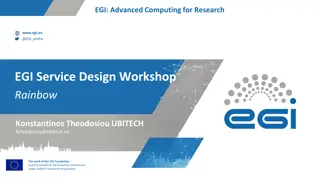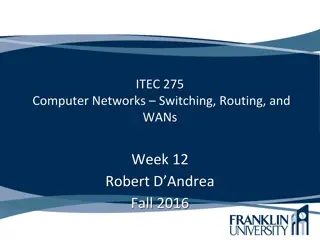Apache MINA: High-performance Network Applications Framework
Apache MINA is a robust framework for building high-performance network applications. With features like non-blocking I/O, event-driven architecture, and enhanced scalability, MINA provides a reliable platform for developing multipurpose infrastructure and networked applications. Its strengths lie i
3 views • 13 slides
Modeling and Generation of Realistic Network Activity Using Non-Negative Matrix Factorization
The GHOST project focuses on the challenges of modeling, analyzing, and generating patterns of network activity. By utilizing Non-Negative Matrix Factorization (NMF), realistic network activity patterns can be created and injected into live wireless networks. Understanding and predicting user behavi
4 views • 28 slides
Automated Anomaly Detection Tool for Network Performance Optimization
Anomaly Detection Tool (ADT) aims to automate the detection of network degradation in a mobile communications network, reducing the time and effort required significantly. By utilizing statistical and machine learning models, ADT can generate anomaly reports efficiently across a large circle network
8 views • 7 slides
Open Source 5G Solution for Industrial Edge
Explore an open source 5G solution designed for industrial edge applications, providing flexibility, scalability, and adaptability to evolving 5G technology. This solution enables customization of networks, avoids vendor lock-in, and showcases various industrial edge solutions based on open source p
7 views • 19 slides
Revolutionizing Network Management with Intent-Based Networking
Explore the concept and benefits of Intent-Based Networking (IBN) in simplifying network configuration and enhancing efficiency. Learn how IBN automates network operations, aligns with business objectives, improves security, and ensures scalability and reliability. Discover the potential of IBN tool
0 views • 14 slides
Network Compression Techniques: Overview and Practical Issues
Various network compression techniques such as network pruning, knowledge distillation, and parameter quantization are discussed in this content. The importance of pruning redundant weights and neurons in over-parameterized networks is highlighted. Practical issues like weight pruning and neuron pru
0 views • 37 slides
Network Slicing with OAI 5G CN Workshop Overview
Overview of Network Slicing with OAI 5G CN workshop focusing on the crucial role of network slicing in realizing the service-oriented 5G vision. This workshop covers topics like multiple logical networks creation on shared infrastructure, different types of network slices, preparation and instantiat
1 views • 6 slides
Network Design Challenges and Solutions in Business Data Communications
Issues in designing a Local Area Network (LAN) include needs analysis, technological design, and cost assessment. The traditional approach involves structured systems analysis, but faces challenges due to rapidly changing technology and increasing network traffic. The Building Blocks Approach recomm
1 views • 20 slides
Understanding 5G RAN Network Slicing and Architecture
Explore the intricate world of 5G Radio Access Network (RAN) and Network Slicing, delving into concepts such as SO Service Orchestrator, SDN-C Service Design, and Core Network Elements. Discover the significance of managing and designing mobile slice services, including eMBB, Massive IoT, and Missio
0 views • 26 slides
Understanding Snort: An Open-Source Network Intrusion Detection System
Snort is an open-source Network Intrusion Detection System (NIDS) developed by Cisco, capable of analyzing network packets to identify suspicious activities. It can function as a packet sniffer, packet logger, or a full-fledged intrusion prevention system. By monitoring and matching network activity
0 views • 23 slides
Zero Touch Network and Service Management Architecture Overview
Explore the ETSI ZSM ISG's initiative on Zero Touch Network and Service Management, focusing on creating an automated architecture supporting legacy and virtualized networks. Learn about the framework, architecture features, and services offered within the ZSM domain. Dive into E2E service managemen
0 views • 9 slides
Data Flows and Network Challenges in Particle Physics Infrastructure
This overview delves into the data flows and network challenges faced in particle physics infrastructure, focusing on the JUNO project. It discusses the process of data reception, storage, and replication across various data centers, highlighting the bidirectional nature of data flows. Additionally,
0 views • 24 slides
Progress of Network Architecture Work in FG IMT-2020
In the Network Architecture Group led by Namseok Ko, significant progress has been made in defining the IMT-2020 architecture. The work has involved gap analysis, draft recommendations, and setting framework and requirements. Phase 1 focused on identifying 19 architectural gaps, such as demands for
1 views • 11 slides
Understanding Interconnection Networks Topology
Exploring the topology of interconnection networks helps determine the arrangement of channels and nodes, impacting network cost, performance, latency, energy consumption, and complexity of implementation. Abstract metrics such as degree, hop count, and network diameter play crucial roles in evaluat
1 views • 56 slides
Transportation Network Modeling and Analysis with C.Coupled SE Platform
This content outlines the features and functionalities of the C.Coupled SE Platform (CSET Platform) developed by the Connetics Transportation Group. It covers aspects such as interface design, inputs merging, purposes, platform development using Cube, TAZs merging, and network attributes. The platfo
0 views • 11 slides
Evolution of DevOps in Technology Through Images
Explore the evolution of DevOps through images showcasing key milestones from the AT&T Bell Labs UNIX era to modern DevOps teams at Google and Facebook. Delve into the analogy of a combustion engine to understand the roles of developers, operations, and orchestration in the DevOps ecosystem. Gain in
1 views • 10 slides
Human Disease Symptom Network: Understanding Disease Relationships Through Symptoms and Genes
The Human Disease Symptom Network (HSDN) is constructed using a large-scale medical bibliographic records database to form a network of human diseases based on symptom similarities. By integrating disease-gene associations and protein-protein interaction data, correlations between symptom similarity
0 views • 37 slides
Introduction to Network Analysis Using .NET
This presentation introduces the concept of network analysis using .NET in the humanities classroom. It provides a template for teaching and adapting network analysis tools for educational purposes. The guide explains the relevance of networks in processing and visualizing data, emphasizing the coll
0 views • 20 slides
Understanding Network Automation and Orchestration with SaltStack
Explore the world of network automation and orchestration with SaltStack, addressing common concerns, streamlining workflows, leveraging NAPALM for multi-vendor support, and utilizing the SaltStack platform for automation and configuration management. Discover how to manage network gear efficiently
0 views • 13 slides
Meridian: An SDN Platform for Cloud Network Services
Meridian is an SDN platform developed by Mohammad Banikazemi, David Olshefski, Anees Shaikh, John Tracey, and GuohuiWang at IBM T. J. Watson Research Center. The platform focuses on providing cloud network services efficiently. It encompasses an architecture that enables faster and more convenient n
0 views • 21 slides
Enhancing Network Security with Software-Defined Snort and OpenFlow
Explore the implementation of Snort, Barnyard, and PulledPork within a Software-Defined Network framework using OpenFlow technology. Learn how these tools enhance network security through intrusion detection engines, rule management, and network traffic control mechanisms. Dive into the architecture
0 views • 15 slides
Understanding Network Metrics Through Centrality Analysis
This presentation introduces network metrics as tools to describe network characteristics and answer important questions. Using centrality metrics as an example, participants learn how to identify the most important nodes in a network based on different criteria such as degree centrality and closene
0 views • 15 slides
Role of Statistical Standards in Building National Data Backbones
The role of statistical standards in constructing national data backbones is crucial for efficient data dissemination and reporting, especially in the context of Sustainable Development Goals (SDGs). Statistical standards guide the orchestration of information flows within a national statistical net
0 views • 22 slides
Understanding Network Analysis: Whole Networks vs. Ego Networks
Explore the differences between Whole Networks and Ego Networks in social network analysis. Whole Networks provide comprehensive information about all nodes and links, enabling the computation of network-level statistics. On the other hand, Ego Networks focus on a sample of nodes, limiting the abili
0 views • 31 slides
Hunting Cross-Site Scripting Attacks in the Network
Detect suspicious URLs and prevent XSS attacks with xHunter, a tool by Elias Athanasopoulos and team at FORTH-ICS, Greece. Explore the motivation, current status, targets, and orchestration of XSS incidents. Learn about the anatomy of XSS exploits and the operation of xHunter in identifying JavaScri
0 views • 48 slides
Understanding Network Interference in CS590B/690B Lecture
Delve into the realm of network interference through the CS590B/690B lecture with Phillipa Gill at UMass Amherst. Explore topics such as Internet routing, timing attacks, BGP hijacks, Tor network functionality, relay selection, collusion scenarios, use of guards, web site fingerprinting attacks, tra
0 views • 11 slides
Advancing BPaaS Research: PaaS Orchestration & Adaptation
Delve into the realm of Business Process as a Service (BPaaS) with a focus on PaaS orchestration and adaptation. Explore how to leverage cloud providers across all layers and adapt deployments to meet evolving needs seamlessly. Discover innovative solutions for orchestrating PaaS components and enha
0 views • 29 slides
Contribution of HALA Network to ATM Community and SESAR 2020: Achievements and Future Directions
HALA network has been instrumental in fostering research and innovation in the field of automation for ATM systems, providing a platform for knowledge dissemination, collaboration, and advancement. The network has facilitated exploratory research, encouraged young scientists' participation, and crea
0 views • 12 slides
Exploring Network Slicing in Future 5G Networks
The research delves into the design of a 5G-ready architecture known as NFV-based Network Store, aiming to serve as a digital distribution platform for 5G applications. By focusing on network slicing and programmability, the architecture enhances resource efficiency and agility in deploying software
0 views • 17 slides
Comprehensive Overview of Software Defined Networking Programming in OpenDaylight
OpenDaylight is a versatile platform that offers a wide array of choices for orchestration and control in Software Defined Networking (SDN). It embraces various models, protocols, and projects to address operational issues and provide innovative solutions in SDN programming. The presentation covers
0 views • 25 slides
Understanding LSA Scaling and Performance in Network Service Orchestration
Explore the concepts of Link State Advertisements (LSA) and how they impact scaling, performance, and reliability in Network Service Orchestration (NSO). Learn about different cluster models, terminology, and strategies for achieving scalability with LSA, along with comparisons between LSA clusters
0 views • 26 slides
Overview of IMT-2020 Technical Packages by WP1/13
The IMT-2020 technical packages by WP1/13 consist of various documents related to softwarization, fixed-mobile convergence, and information-centric networking. These packages include terms and definitions, management frameworks, network requirements, architecture, orchestration for network slicing,
0 views • 5 slides
Network Function Virtualization (NFV) Overview
Network Function Virtualization (NFV) focuses on virtualizing network functions to improve efficiency and reduce costs in network infrastructure. The lecture discusses key readings, devices that compose a network, specialization of devices, benefits of one-device-does-anything approach, and the goal
0 views • 21 slides
Enhancing Network Stability with Network Monitoring Systems
Network monitoring is crucial for efficient management and proactive issue detection in a network environment. Factors influencing an effective network system include choosing the best OEM, SLA agreements, and selecting a reliable System Integrator. Reactive monitoring can lead to financial losses a
0 views • 12 slides
Introducing Rainbow Platform: Innovative IoT Orchestration and Analytics
Explore the Rainbow platform, funded under Horizon2020, offering intelligent middleware tools for IoT orchestration, data collection, and decentralized analytics. It provides secure and efficient fog computing services for various applications, benefitting cloud platforms and data management engines
0 views • 9 slides
Dell Network Consulting Services Overview
Dell Network Consulting provides expert insights and workshops to enhance your network infrastructure's efficiency. Services include network assessments, topology discovery, traffic analysis, and wireless site assessments. Deliverables include detailed reports, remediation plans, and infrastructure
1 views • 5 slides
Overview of MEF Modeling Activities in LSO and Network Evolution
This content outlines MEF's modeling activities in the context of Lifecycle Service Orchestration (LSO) and the evolving landscape of network services. It covers challenges, the vision for agile networks, lifecycle service orchestration capabilities, and the methodology for engineering LSO capabilit
0 views • 17 slides
Understanding Network Testing in Modern Computing Environments
Today, network connections are essential for various computing tasks, from accessing the internet to setting up local area networks. This article delves into the importance of evaluating existing networks, testing network performance, and ensuring stable connections for optimal user experience. It d
0 views • 46 slides
Accelerating Systemic Change Network Inaugural Workshop Summary
The Accelerating Systemic Change Network held its inaugural workshop at Howard Hughes Medical Institute in July 2016 to address the lack of coordination in improving higher education. With a vision to become a professional hub for change researchers in STEM education, the network aims to enhance ind
0 views • 5 slides
University Network Section Overview July 2015 - March 2016
The presentation covers the network team structure, team members, objectives, goals, report outline, network statistics, accomplishments, and future plans of the university network section from July 2015 to March 2016. It highlights efforts to provide stable internet and intranet services, restructu
0 views • 16 slides







































